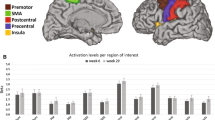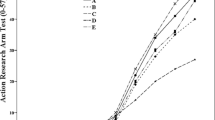Abstract
Motor dysfunction and recovery following stroke and rehabilitation are associated with primary motor cortex plasticity. To better track these effects we studied two patients with sub-acute sub-cortical stroke causing hemiparesis, who underwent an effective behavioral treatment termed Constraint Induced Movement Therapy (CIMT). The therapy involves 2 weeks of intensive motor training of the hemiparetic limb coupled with immobilization of the unaffected limb. The study included a longitudinal series of clinical evaluations and fMRI scans, before and after the treatment. The fMRI task included wrist, elbow, or ankle movements. Activity in the M1 upper-limb region of control subjects was stable, strictly contralateral, and similar in amplitude for elbow and wrist movements. These findings reflect the well-known contralateral motor control and support the idea of overlapping representations of adjacent joints in M1. In both patients, pre-CIMT activation patterns in M1 were tested twice and did not change significantly, were contralateral, and included elbow-wrist differences. Following CIMT, the clinical condition of both patients improved and three fMRI-explored prototypes were found: First, cluster position remained constant; Second, ipsilateral activity appeared in the unaffected hemispheres during hemiparetic movements; Third, patient-specific elbow-wrist inter and intra hemispheric differences were modified. All effects were long-lasting. We suggest that overlapping representations of adjacent joints contributed to the cortical plasticity observed following CIMT. Our findings should be confirmed by studying larger groups of homogeneous patients. Nevertheless, this study introduces multi-joint imaging studies and shows that it is both possible and valuable to carry it out in stroke patients.







Similar content being viewed by others
References
Blankenburg F, Ruben J, Meyer R, Schwiemann J, Villringer A (2003) Evidence for a rostral-to-caudal somatotopic organization in human primary somatosensory cortex with mirror-reversal in areas 3b and 1. Cereb Cortex 13(9):987–993
Boake C, Noser EA, Ro T, Baraniuk S, Gaber M, Johnson R, Salmeron ET, Tran TM, Lai JM, Taub E, Moye LA, Grotta JC, Levin HS (2007) Constraint-induced movement therapy during early stroke rehabilitation. Neurorehabil Neural Repair 21(1):14–24
Butefisch CM, Wessling M, Netz J, Seitz RJ, Homberg V (2008) Relationship between interhemispheric inhibition and motor cortex excitability in subacute stroke patients. Neurorehabil Neural Repair 22(1):4–21
Calautti C, Baron JC (2003) Functional neuroimaging studies of motor recovery after stroke in adults: a review. Stroke 34(6):1553–1566
Calautti C, Naccarato M, Jones PS, Sharma N, Day DD, Carpenter AT, Bullmore ET, Warburton EA, Baron JC (2007) The relationship between motor deficit and hemisphere activation balance after stroke: a 3T fMRI study. Neuroimage 34(1):322–331
Cao Y, D’Olhaberriague L, Vikingstad EM, Levine SR, Welch KM (1998) Pilot study of functional MRI to assess cerebral activation of motor function after poststroke hemiparesis. Stroke 29(1):112–122
Carey JR, Kimberley TJ, Lewis SM, Auerbach EJ, Dorsey L, Rundquist P, Ugurbil K (2002) Analysis of fMRI and finger tracking training in subjects with chronic stroke. Brain 125(Pt 4):773–788
Chouinard PA, Leonard G, Paus T (2006) Changes in effective connectivity of the primary motor cortex in stroke patients after rehabilitative therapy. Exp Neurol 201(2):375–387
Cohen LG, Bandinelli S, Findley TW, Hallett M (1991) Motor reorganization after upper limb amputation in man. A study with focal magnetic stimulation. Brain 114(Pt 1B):615–627
Cramer SC, Riley JD (2008) Neuroplasticity and brain repair after stroke. Curr Opin Neurol 21(1):76–82
Darian-Smith C (2009) Synaptic plasticity, neurogenesis, and functional recovery after spinal cord injury. Neuroscientist 15(2):149–165
Darian-Smith C, Brown S (2000) Functional changes at periphery and cortex following dorsal root lesions in adult monkeys. Nat Neurosci 3(5):476–481
Darian-Smith C, Ciferri MM (2005) Loss and recovery of voluntary hand movements in the macaque following a cervical dorsal rhizotomy. J Comp Neurol 491(1):27–45
Devanne H, Cassim F, Ethier C, Brizzi L, Thevenon A, Capaday C (2006) The comparable size and overlapping nature of upper limb distal and proximal muscle representations in the human motor cortex. Eur J Neurosci 23(9):2467–2476
Dijkhuizen RM, Ren J, Mandeville JB, Wu O, Ozdag FM, Moskowitz MA, Rosen BR, Finklestein SP (2001) Functional magnetic resonance imaging of reorganization in rat brain after stroke. Proc Natl Acad Sci USA 98(22):12766–12771
Dong Y, Dobkin BH, Cen SY, Wu AD, Winstein CJ (2006) Motor cortex activation during treatment may predict therapeutic gains in paretic hand function after stroke. Stroke 37(6):1552–1555
Donoghue JP, Leibovic S, Sanes JN (1992) Organization of the forelimb area in squirrel monkey motor cortex: representation of digit, wrist, and elbow muscles. Exp Brain Res 89(1):1–19
Fries W, Danek A, Scheidtmann K, Hamburger C (1993) Motor recovery following capsular stroke. Role of descending pathways from multiple motor areas. Brain 116(Pt 2):369–382
Fugl-Meyer AR, Jaasko L, Leyman I, Olsson S, Steglind S (1975) The post-stroke hemiplegic patient. 1. A method for evaluation of physical performance. Scand J Rehabil Med 7(1):13–31
Gerloff C, Bushara K, Sailer A, Wassermann EM, Chen R, Matsuoka T, Waldvogel D, Wittenberg GF, Ishii K, Cohen LG, Hallett M (2006) Multimodal imaging of brain reorganization in motor areas of the contralesional hemisphere of well recovered patients after capsular stroke. Brain 129(Pt 3):791–808
Hamzei F, Liepert J, Dettmers C, Weiller C, Rijntjes M (2006) Two different reorganization patterns after rehabilitative therapy: an exploratory study with fMRI and TMS. Neuroimage 31(2):710–720
Hlustik P, Solodkin A, Gullapalli RP, Noll DC, Small SL (2001) Somatotopy in human primary motor and somatosensory hand representations revisited. Cereb Cortex 11(4):312–321
Indovina I, Sanes JN (2001) On somatotopic representation centers for finger movements in human primary motor cortex and supplementary motor area. Neuroimage 13(6 Pt 1):1027–1034
Jansen A, Menke R, Sommer J, Forster AF, Bruchmann S, Hempleman J, Weber B, Knecht S (2006) The assessment of hemispheric lateralization in functional MRI-robustness and reproducibility. Neuroimage 33(1):204–217
Johansen-Berg H, Dawes H, Guy C, Smith SM, Wade DT, Matthews PM (2002) Correlation between motor improvements and altered fMRI activity after rehabilitative therapy. Brain 125(Pt 12):2731–2742
Kleinschmidt A, Nitschke MF, Frahm J (1997) Somatotopy in the human motor cortex hand area. A high-resolution functional MRI study. Eur J Neurosci 9(10):2178–2186
Knapp HD, Taub E, Berman AJ (1963) Movements in monkeys with deafferented forelimbs. Exp Neurol 7:305–315
Kwan HC, MacKay WA, Murphy JT, Wong YC (1978) Spatial organization of precentral cortex in awake primates. II. Motor outputs. J Neurophysiol 41(5):1120–1131
Liepert J, Tegenthoff M, Malin JP (1995) Changes of cortical motor area size during immobilization. Electroencephalogr Clin Neurophysiol 97(6):382–386
Liepert J, Bauder H, Wolfgang HR, Miltner WH, Taub E, Weiller C (2000) Treatment-induced cortical reorganization after stroke in humans. Stroke 31(6):1210–1216
Mark VW, Taub E, Morris DM (2006) Neuroplasticity and constraint-induced movement therapy. Eura Medicophys 42(3):269–284
Meier JD, Aflalo TN, Kastner S, Graziano MS (2008) Complex organization of human primary motor cortex: a high-resolution fMRI study. J Neurophysiol 100(4):1800–1812
Morris DM, Taub E, Mark VW (2006) Constraint-induced movement therapy: characterizing the intervention protocol. Eura Medicophys 42(3):257–268
Nair DG, Hutchinson S, Fregni F, Alexander M, Pascual-Leone A, Schlaug G (2007) Imaging correlates of motor recovery from cerebral infarction and their physiological significance in well-recovered patients. Neuroimage 34(1):253–263
Nudo RJ, Wise BM, SiFuentes F, Milliken GW (1996) Neural substrates for the effects of rehabilitative training on motor recovery after ischemic infarct. Science 272(5269):1791–1794
Park MC, Belhaj-Saif A, Gordon M, Cheney PD (2001) Consistent features in the forelimb representation of primary motor cortex in rhesus macaques. J Neurosci 21(8):2784–2792
Pascual-Leone A, Peris M, Tormos JM, Pascual AP, Catala MD (1996) Reorganization of human cortical motor output maps following traumatic forearm amputation. Neuroreport 7(13):2068–2070
Penfield W, Rasmussen T (1950) The cerebral cortex of man. Macmillan, New York
Pons TP, Garraghty PE, Ommaya AK, Kaas JH, Taub E, Mishkin M (1991) Massive cortical reorganization after sensory deafferentation in adult macaques. Science 252(5014):1857–1860
Rao SM, Binder JR, Hammeke TA, Bandettini PA, Bobholz JA, Frost JA, Myklebust BM, Jacobson RD, Hyde JS (1995) Somatotopic mapping of the human primary motor cortex with functional magnetic resonance imaging. Neurology 45(5):919–924
Rossini PM, Calautti C, Pauri F, Baron JC (2003) Post-stroke plastic reorganisation in the adult brain. Lancet Neurol 2(8):493–502
Sanes JN, Suner S, Lando JF, Donoghue JP (1988) Rapid reorganization of adult rat motor cortex somatic representation patterns after motor nerve injury. Proc Natl Acad Sci USA 85(6):2003–2007
Sanes JN, Donoghue JP, Thangaraj V, Edelman RR, Warach S (1995) Shared neural substrates controlling hand movements in human motor cortex. Science 268(5218):1775–1777
Schaechter JD, Kraft E, Hilliard TS, Dijkhuizen RM, Benner T, Finklestein SP, Rosen BR, Cramer SC (2002) Motor recovery and cortical reorganization after constraint-induced movement therapy in stroke patients: a preliminary study. Neurorehabil Neural Repair 16(4):326–338
Schieber MH (2001) Constraints on somatotopic organization in the primary motor cortex. J Neurophysiol 86(5):2125–2143
Schieber MH, Hibbard LS (1993) How somatotopic is the motor cortex hand area? Science 261(5120):489–492
Seghier ML (2008) Laterality index in functional MRI: methodological issues. Magn Reson Imaging 26(5):594–601
Serrien DJ, Strens LH, Cassidy MJ, Thompson AJ, Brown P (2004) Functional significance of the ipsilateral hemisphere during movement of the affected hand after stroke. Exp Neurol 190(2):425–432
Sheng B, Lin M (2009) A longitudinal study of functional magnetic resonance imaging in upper-limb hemiplegia after stroke treated with constraint-induced movement therapy. Brain Inj 23(1):65–70
Sterr A, Elbert T, Berthold I, Kölbel S, Rockstroh B, Taub E (2002) Longer versus shorter daily constraint-induced movement therapy of chronic hemiparesis: an exploratory study. Arch Phys Med Rehabil 83(10):1374–1377
Szaflarski JP, Page SJ, Kissela BM, Lee JH, Levine P, Strakowski SM (2006) Cortical reorganization following modified constraint-induced movement therapy: a study of 4 patients with chronic stroke. Arch Phys Med Rehabil 87(8):1052–1058
Taub E, Heitmann RD, Barro G (1977) Alertness, level of activity, and purposive movement following somatosensory deafferentation in monkeys. Ann N Y Acad Sci 290:348–365
Taub E, Miller NE, Novack TA, Cook EW 3rd, Fleming WC, Nepomuceno CS, Connell JS, Crago JE (1993) Technique to improve chronic motor deficit after stroke. Arch Phys Med Rehabil 74(4):347–354
Taub E, Uswatte G, Mark VW, Morris DM (2006) The learned nonuse phenomenon: implications for rehabilitation. Eura Medicophys 42(3):241–256
van der Lee JH, Wagenaar RC, Lankhorst GJ, Vogelaar TW, Deville WL, Bouter LM (1999) Forced use of the upper extremity in chronic stroke patients: results from a single-blind randomized clinical trial. Stroke 30(11):2369–2375
Vierck CJ Jr (1982) Comparison of the effects of dorsal rhizotomy or dorsal column transection on motor performance of monkeys. Exp Neurol 75(3):566–575
Ward NS, Brown MM, Thompson AJ, Frackowiak RS (2003) Neural correlates of outcome after stroke: a cross-sectional fMRI study. Brain 126(Pt 6):1430–1448
Wenzelburger R, Kopper F, Frenzel A, Stolze H, Klebe S, Brossmann A, Kuhtz-Buschbeck J, Golge M, Illert M, Deuschl G (2005) Hand coordination following capsular stroke. Brain 128(Pt 1):64–74
Wittenberg GF, Chen R, Ishii K, Bushara KO, Eckloff S, Croarkin E, Taub E, Gerber LH, Hallett M, Cohen LG (2003) Constraint-induced therapy in stroke: magnetic-stimulation motor maps and cerebral activation. Neurorehabil Neural Repair 17(1):48–57
Wolf SL, Catlin PA, Ellis M, Archer AL, Morgan B, Piacentino A (2001) Assessing Wolf motor function test as outcome measure for research in patients after stroke. Stroke 32(7):1635–1639
Wolf SL, Winstein CJ, Miller JP, Taub E, Uswatte G, Morris D, Giuliani C, Light KE, Nichols-Larsen D (2006) Effect of constraint-induced movement therapy on upper extremity function 3 to 9 months after stroke: the EXCITE randomized clinical trial. Jama 296(17):2095–2104
Acknowledgments
We thank Ehud Zohary and Eran Stark for insightful comments, and Yitshak Simhayoff for constructing the fMRI roller apparatus. This research was supported by the Israeli Ministry of Health, grant 3-2026.
Author information
Authors and Affiliations
Corresponding author
Electronic supplementary material
Below is the link to the electronic supplementary material.
Rights and permissions
About this article
Cite this article
Stark, A., Meiner, Z., Lefkovitz, R. et al. Plasticity in Cortical Motor Upper-Limb Representation Following Stroke and Rehabilitation: Two Longitudinal Multi-Joint fMRI Case-Studies. Brain Topogr 25, 205–219 (2012). https://doi.org/10.1007/s10548-011-0201-2
Received:
Accepted:
Published:
Issue Date:
DOI: https://doi.org/10.1007/s10548-011-0201-2




